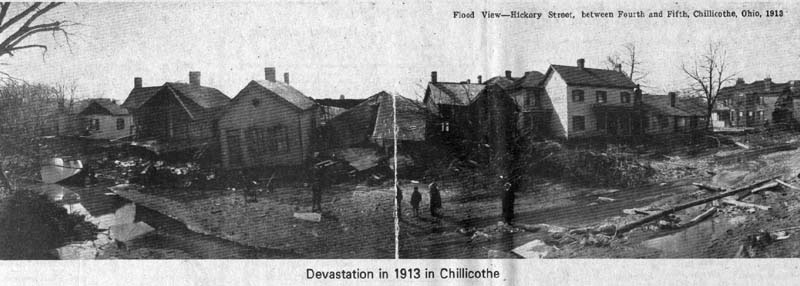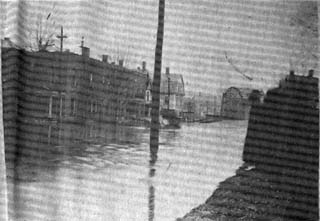April 6, 1978


Pictures #1 & #2 – Devastation in 1913 in Chillicothe
As sure as day follows night, so high waters come after the winter blizzards and when snow and ice starts to melt.
The news media have informed us of the high-water conditions across the nation, but it is always interesting to look at the high-water conditions that existed in other days.
This week’s POTLUCK turns to the 1913 floods that prevailed in Ohio.
The one photo shows the devastation that followed flooding at Chillicothe, Ohio 1913. When your editor crossed the Ohio River on the return trip from Florida recently and passed through that area there was evidence of high water. But the water had not yet crested and there was no evidence of wide spread damage. Bits of debris could be seen floating on the river.
Back in 1913, Tiffin, on the Sandusky River was devastated by high water, as the other photo shows. the photo was taken on what was then called Water Street…now called Frost Parkway.
One Tiffin old-timer relates that the high water mark can still be seen on the presently vacated Shawhan Hotel at corner of Washington and Perry street, Tiffin.
Mrs. Lula Brumbaugh, a Tiffin resident, who at that time lived in Fostoria, has told you editor that during the 1913 flood whenever she and her husband visited Tiffin relatives they carried as much bread as they could to them, since all the west portion of Tiffin was segregated from the business section. The interurban cars continued to run to Tiffin, but stopped on this side of the river.
Harold Henery, a one-time Fostorian, who lived in tiffin at the time of the floor, recently related that he saw all of the old stall-structured bridges that spanned the river, carried away one-by-one. The old railroad bridge farther down the river was elevated higher above the river and withstood the floor.
After the 1913 experience, new bridge were built at Market, Perry and Washington Streets, and containing walls were built on both sides of the river through the business district. Since then high waters have not caused flooding in that area, although low areas above and below Tiffin have often been inundated.
Your editor’s wife, a Tiffin-born gal, was only a child of four at the time of the 1913 flood, and does not remember the incident. Her parents lived on Wentz Street, west of the river and were sale from the high water.
OUR FLORIDA VACATION
February 20…completely fedup with the 1978 weather, we took off for Florida …to soak up some sunshine and get rid of homesickness for our daughter, Janet and family.
What a relief to get away from the snow and cold…to walk on the Atlantic beach…hunt shells…see old Fostoria friends now living in Florida, some permanently and others for the winter…and to visit places of interest.
On our previous trips to Florida we had not been to Disney World. Taking it in on this trip, I must now say it is a wonderful experience…worth the cost …but it should be done in two days instead of one. In addition to fun, it is educational, historical in many of the exhibits.
Also, don’t miss Ringling Bros. Circus World if you go to Florida. In the absence of the 3-ring curcus it is an excellent substitute…parade…well trained horse acts…wild animal acts…clowns…aerialists…excellent circus band…and much more. Go early and stay late to see it all.
We were on both Atlantic and Gulf coasts. Must construction going on, particularly in Melbourne area on Atlantic side.
Many readers will remember Myra Kershaw, daughter of W.L. Kershaw secretary of YMCA many years ago. She and her husband now living at Cedar Key, Florida on a key that extends out into gulf two miles. From their fishing pier and boat dock is a wonderful view of islands and the gulf. Good fishing and oyster beds nearby…also rock crab. Enjoyed visit with them.
Would have stayed in Florida longer, but duties called us back…including work on future POTLUCK articles.
READER FEEDBACK
The article about the eastend railroad yards brought back memories to many readers…a few of which are repeated here, from those who have contacted me.
“I remember helping you in your mushroom gardens, and all the other names and places in your column. I have a picture of Vernon Earl (named in story) taken in the old McDougal street neighborhood. My wife and I read your column regularly, and talk about it”. Clarence Vanderhoff
“Your railroad yards story brought back a special memory…it reminded me of the Wernick reduction plant that was located near the Hocking Valley tracks at the north edge of town (at the Wernick plant, dead animals were reduced to fertilizer…the hides salvaged and shipped to tanners in Chicago). Mr. Wernick kept a cow at the plant to provide milk for his family, and my father provided hay for the cow. I delivered the hay in a horsedrawn farm wagon. When the horses approached the reduction plant and smelled the dead horses and other animals being processed, they reared up and were hard to handle. Royal Shoemaker.
“Paul, I surely enjoy your articles. In the one about the eastend railroad yards, I remember all of it, including your mushroom plant I thought you would have included Earl “goat” Adams name. In fact, I always thought the mushroom gardens belonged to him (I assured him Adams helped me at the gardens) Keep up the good work, Paul, – Ken Murphy.